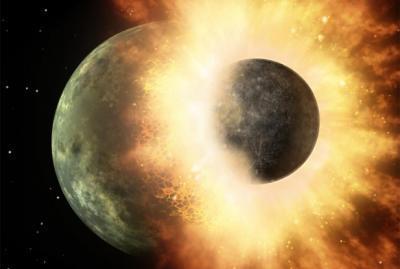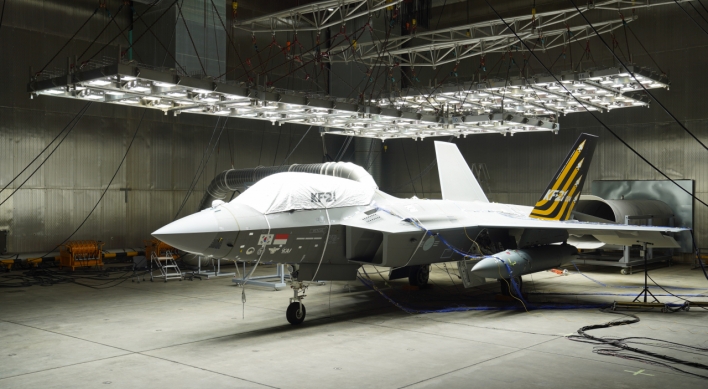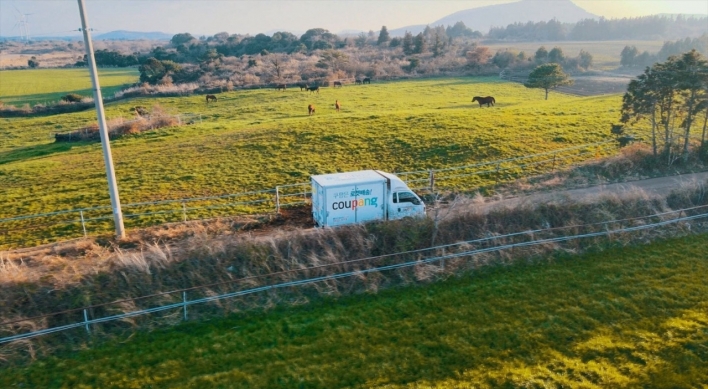
A chemical quirk found in lunar soil backs a 37-year-old theory that the Moon was born from an apocalyptic collision between Earth and a huge space rock, scientists said on Wednesday.
Way back in 1975, astronomers proposed at a conference that billions of years ago, our satellite was created through a smashup between the infant Earth and a Mars-sized body they named Theia, in Greek mythology the mother of the moon, Selene.
The collision melted and vaporized Theia and much of Earth's nascent mantle, and the rock vapor condensed to form the Moon.
This would explain why the Moon is so big -- it is about a quarter the size of Earth and the fifth biggest satellite in the Solar System -- and so near to us.
For years, the "Giant Impact Theory" lingered in the margins until computer simulations showed that it could be true.
Sifting through precious grains of lunar soil brought back by the Apollo missions, researchers say they have now found chemical proof to validate the concept.
It lies in a minute excess in a heavier isotope, or atomic variant, of the element zinc.
This enrichment would have happened because heavier zinc atoms would have been condensed swiftly in the vapor cloud rather than lighter ones.
The tiny but telltale difference is called isotopic fractionation.
"The magnitude of the fractionation we measured in lunar rocks is 10 times larger than what see in terrestrial and Martian rocks," said Frederic Moynier, an assistant professor of Earth and Planetary Sciences at Washington University in St. Louis, Missouri. "It's an important difference."
The fractionation was sought in 20 samples of lunar rocks from four Apollo missions, which explored different areas of the Moon, and from one lunar meteorite.
These were matched against 10 meteorites that have been identified as being Martian in origin, including one that was in collection at the Vatican, and against rocks found on Earth.
Analysis by a mass spectrometer -- in which light from a vaporized sample points to the elements in it -- showed that zinc in general was severely depleted on the Moon, but bore the signatures of heavier isotopes.
Large-scale evaporation of the zinc points to a mega-event like the collision, rather than localized volcanic activity, the researchers contend.
"You require some kind of wholesale melting event of the Moon to provide the heat necessary to evaporate the zinc," said James Day of the Scripps Institution of Oceanography in California.
With this success, say the researchers, the Great Impact Theory could be the key to understanding another mystery: why is Earth so endowed with water but the Moon so dry?
"This is a very important question, because if we are looking for life on other planets, we have to recognize that similar conditions are probably required," said Day.
"So understanding how planets obtain such conditions is critical for understanding how life ultimate occurs on a planet."
The study appears in the British journal Nature. (AFP)
<관련 한글 기사>
달은 어떻게 생겨났을까?
약 45억년 전 화성 크기의 천체가 원시 지구와 충돌하면서 부서져 나간 파편들이 뭉쳐서 달이 됐다는, 이른바 `대충돌 가설'에 힘을 실어주는 새 로운 연구들이 한꺼번에 쏟아져 나오고 있다.
17일자 사이언스지 온라인판에 실린 연구 보고서들은 각기 다른 방식으로 충돌설에 남아 있는 의문점들을 설명한다고 스페이스 닷컴과 사이언스 데일리가 보도했다.
`테이아'로 불리는 천체가 지구와 충돌해 달이 됐다는, 1975년 처음 발표된 대충돌 이론에 따르면 달의 주성분은 테이아의 파편들이지만 아폴로 우주선이 가져온 달 암석 분석 결과 달과 지구의 성분이 같은 것으로 밝혀지면서 도전을 받아왔다.
그러나 사이언스지에 실린 두 연구는 모두 지구와 달이 같은 화학적 조성을 갖게 된 과정을 논리적으로 설명한다. 다만 둘의 논리가 각기 달라 과학자들은 새로운 문제를 떠안게 됐다.
미국 캘리포니아주 마운틴뷰 소재 외계지적생명체탐사(SETI) 연구소와 하버드대 과학자들의 공동 연구는 지구의 자전속도에서 그 답을 찾고 있다.
이들은 달을 만들만한 양의 물질이 떨어져 나가기 위해서는 충돌시 지구의 자전 주기가 2~3시간 정도였어야 한다고 지적했다. 이는 행성이 분해될 만큼 빠른 속도에 육박한 것이다.
그러나 연구진은 당시 태양계가 수많은 충돌이 일상적으로 일어나는 `사격연습장' 같은 공간이었다면서 이로 인해 행성들은 믿을 수 없을 만큼 빠른 속도로 자전하고 있었을 것이라고 주장했다.
이들은 지구의 자전 속도가 이후 느려진 것은 대충돌 이후 지구의 공전 궤도와 달의 공전궤도 사이의 중력 상호작용에 의해 지구의 자전속도에 제동이 걸려 마침내 24시간이 된 것이라고 추정했다.
이들의 가설이 지구 질량의 5~10% 정도인 천체와의 충돌을 가정한데 비해 또 하나의 연구는 비슷한 질량의 행성이 충돌한 상황을 시뮬레이션했다.
사우스웨스트연구소(SwRI) 과학자들은 기존 가설에서 설정됐던 `화성만한 천체'보다 큰 질량의 충돌체를 등장시킨 새로운 모델을 통해 지구와 달이 같은 성분을 갖게 된 과정을 설명한다.
이 모델에 따르면 화성 질량의 4~5배 정도인 천체가 역시 비슷한 질량의 지구와 충돌했을 경우 대칭에 가까운 충돌에 의해 달 구성 물질로 이루어진 원반의 성분이 지구 맨틀층 성분과 극도로 비슷해지는 것으로 나타났다.
한편 스크립스 해양연구소 과학자들은 화성 크기의 천체가 원시 지구와 충돌한 결과로 달이 탄생했음을 입증하는 증거를 발견했다고 네이처지에 발표했다.
이들은 아폴로 우주선이 지구로 가져온 달 암석을 분석한 결과 달이 탄생할 무렵 막대한 양의 물이 끓어 증발한 것으로 나타났다고 밝혔다.
연구진은 달 암석 속의 아연 원소 중 무거운 동위원소가 지구에 비해 약간 많은 것으로 나타났으며 이는 충돌로 인해 일어난 암석 성분 파편 구름에서 무거운 아연 원자가 가벼운 원자보다 빠르게 농축됐고 나머지는 농축되기 전에 증발했기 때문이라고 설명했다.
학자들은 대충돌이 비록 45억년 전에 일어난 사건이긴 하지만 언젠가는 수많은 연구가 합쳐져 실제 상황을 알 수 있게 될 것으로 본다.






![[KH Explains] Can tech firms' AI alliances take on Nvidia?](http://res.heraldm.com/phpwas/restmb_idxmake.php?idx=644&simg=/content/image/2024/05/07/20240507050619_0.jpg&u=)

![[Grace Kao, Meera Choi] Has money displaced romance on dates?](http://res.heraldm.com/phpwas/restmb_idxmake.php?idx=644&simg=/content/image/2024/05/06/20240506050233_0.jpg&u=)








![[K-pop’s dilemma] Time, profit pressures work against originality](http://res.heraldm.com/phpwas/restmb_idxmake.php?idx=652&simg=/content/image/2024/05/08/20240508050705_0.jpg&u=20240508171126)
![[Today’s K-pop] NCT Dream to drop pre-release from 2nd Japan single](http://res.heraldm.com/phpwas/restmb_idxmake.php?idx=642&simg=/content/image/2024/05/08/20240508050725_0.jpg&u=)